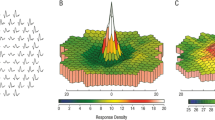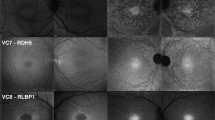Abstract
Background
Spectral-domain optical coherence tomography (SD-OCT) and full-field electroretinography (ERG) allow retinal assessment with vitamin A deficiency (VAD). Using SD-OCT, this study aimed to characterize and follow a novel retinal abnormality in patients with VAD and intramuscular supplementation.
Methods
Patients with VAD were retrospectively reviewed, including SD-OCT and electroretinography.
Results
Three patients had VAD following bariatric or colon surgery and varying supplementation. All had nyctalopia, extinguished scotopic rod-specific function with ERG, and decreased serum vitamin A. None demonstrated surface abnormalities. All received intramuscular vitamin A with subjective resolution of symptoms. On SD-OCT, four of six eyes exhibited homogenous foveal hyperreflectivity anterior to retinal pigment epithelium-Bruch complex, reminiscent of a “double carrot”, which improved following supplementation. ERG findings demonstrated improved scotopic rod-specific function in all cases; however, photopic function remained diminished in two cases.
Conclusions
Structural improvement of the proposed “double carrot” sign occurs soon after vitamin A supplementation. While scotopic function improves rapidly following supplementation, cone function recovers more slowly. Therefore, foveal changes such as the “double carrot” sign suggest that structural recovery of cones precedes functional recovery.
This is a preview of subscription content, access via your institution
Access options
Subscribe to this journal
Receive 18 print issues and online access
$259.00 per year
only $14.39 per issue
Buy this article
- Purchase on Springer Link
- Instant access to full article PDF
Prices may be subject to local taxes which are calculated during checkout




Similar content being viewed by others
Data availability
Authors can confirm that all relevant data are included in the article and/or its supplementary information files.
References
Morais FB. Vision and the Nobel Prize. Arq Bras Oftalmol. 2018;81:161–5.
Jalilvand A, Blaszczak A, Needleman B, Hsueh W, Noria S. Vitamin A deficiency in patients undergoing sleeve gastrectomy and gastric bypass: a 2-year, single-center review. J Laparoendosc Adv Surg Tech A. 2020;30:20–30.
Tei M, Spurr-Michaud SJ, Tisdale AS, Gipson IK. Vitamin A deficiency alters the expression of mucin genes by the rat ocular surface epithelium. Investig Ophthalmol Vis Sci. 2000;41:82–8.
Genead MA, Fishman GA, Lindeman M. Fundus white spots and acquired night blindness due to vitamin A deficiency. Doc Ophthalmol. 2009;119:229–33.
Lee WB, Hamilton SM, Harris JP, Schwab IR. Ocular complications of hypovitaminosis A after bariatric surgery. Ophthalmology 2005;112:1031–4.
Lewis CA, de Jersey S, Hopkins G, Hickman I, Osland E. Does bariatric surgery cause vitamin A, B1, C or E deficiency? A systematic review. Obes Surg. 2018;28:3640–57.
Green Corkins K. Nutrtion-focused physical examination in pediatric patients. Nutr Clin Pract. 2015;30:203–9.
Pogatshnik C, Hamilton C. Nutrition-focused physical examination: skin, nails, hair, eyes, and oral cavity. Support Line 2011;33:7–13.
Harris EW, Loewenstein JI, Azar D. Vitamin A deficiency and its effects on the eye. Int Ophthalmol Clin. 1998;38:155–61.
Saker S, Morales M, Jhittay H, Wen Y, Amoaku W. Electrophysiological and microperimetry changes in vitamin A deficiency retinopathy. Doc Ophthalmol. 2015;130:231–40.
Aleman TS, Garrity ST, Brucker AJ. Retinal structure in vitamin A deficiency as explored with multimodal imaging. Doc Ophthalmol. 2013;127:239–43.
McCulloch DL, Marmor MF, Brigell MG, Hamilton R, Holder GE, Tzekov R, et al. ISCEV Standard for full-field clinical electroretinography (2015 update). Doc Ophthalmol. 2015;130:1–12. https://doi.org/10.1007/s10633-014-9473-7.
Spaide RF, Ooto S, Curcio CA. Subretinal drusenoid deposits AKA pseudodrusen. Surv Ophthalmol. 2018;63:782–815.
Zweifel SA, Imamura Y, Spaide TC, Fujiwara T, Spaide RF. Prevalence and significance of subretinal drusenoid deposits (reticular pseudodrusen) in age-related macular degeneration. Ophthalmology. 2010;117:1775–81.
Chen L, Messinger JD, Zhang Y, Spaide RF, Freund KB, Curcio CA. Subretinal drusenoid deposit in age-related macular degeneration: Histologic insights into initiation, progression to atrophy, and imaging. Retina. 2020;40:618–31.
Lima de Carvalho JR Jr, Tsang SH, Sparrow JR. Vitamin A deficiency monitored by quantitative short wavelength fundus autofluorescence in a case of bariatric surgery. Retin Cases Brief Rep. 2019;25.
Wald G. The molecular basis of visual excitation. Nature. 1968;219:800–7.
Knox BE, Salcedo E, Mathiesz K, Schaefer J, Chou W, Chadwell LV, et al. Heterologous expression of limulus rhodopsin. J Biol Chem. 2003;278:40493–502.
Lujan BJ, Roorda A, Knighton RW, Carroll J. Revealing Henle’s fiber layer using spectral domain optical coherence tomography. Investig Ophthalmol Vis Sci. 2011;52:1486–92.
Perlman I, Barzilai D, Haim T, Schramek A. Night vision in a case of vitamin A deficiency due to malabsorption. Br J Ophthalmol. 1983;67:37–42.
McBain VA, Egan CA, Pieris SJ, Supramaniam G, Webster AR, Bird AC, et al. Functional observations in vitamin A deficiency: diagnosis and time course of recovery. Eye. 2007;21:367–76.
Singer JR, Bakall B, Gordon GM, Reddy RK. Treatment of vitamin A deficiency retinopathy with sublingual vitamin A palmitate. Doc Ophthalmol. 2016;132:137–45.
Hartline JV, Zachman RD. Vitamin A delivery in total parenteral nutrition solution. Pediatrics 1976;58:448–51.
Renner AB, Dietrich-Ntoukas T, Jägle H. Recurrent episodes of night blindness in a patient with short bowel syndrome. Doc Ophthalmol. 2015;131:221–30.
Funding
Jonas Children’s Vision Care is supported by the National Institute of Health 5P30CA013696, U01EY030580, U54OD020351, R24EY028758, R24EY027285, 5P30EY019007, R01EY018213, R01EY024698, R01EY026682, R21AG050437, R01EY024091, the Schneeweiss Stem Cell Fund, New York State [SDHDOH01-C32590GG-3450000], the Foundation Fighting Blindness New York Regional Research Center Grant [PPA-1218-0751-COLU], Nancy & Kobi Karp, the Crowley Family Funds, The Rosenbaum Family Foundation, Alcon Research Institute, the Gebroe Family Foundation, the Research to Prevent Blindness (RPB) Physician-Scientist Award, and unrestricted funds from RPB, New York, NY, USA, and the Kogod Family (MPB), none of which had any role in study design, collection, analysis and interpretation of data, writing the report, and the decision to submit the report for publication.
Author information
Authors and Affiliations
Contributions
Each author contributed to the manuscript as follows: design and conduct of the study (M.P.B., J.K.O., S.H.T.) collection, management, analysis, and interpretation of the data (M.P.B., J.K.O., J.R.S., S.F., S.H.T.); preparation, review, or approval of the manuscript and decision to submit for publication (M.P.B., J.K.O., S.A.B., J.A.K., R.K., C.M.R. J.R.S., S.F., S.H.T.). At least two authors (M.P.B., J.K.O.) had full access to all the data in the study and take responsibility for the integrity of the data and the accuracy of the data analysis.
Corresponding author
Ethics declarations
Competing interests
The authors declare no competing interests.
Ethics approval and consent to participate
The need for patient consent was waived due to minimal risk offered to patients and the retrospective nature of this study design as per Columbia University Institutional Review Board approved protocol AAAR8743. All procedures were reviewed and in accordance with the tenets of the Declaration of Helsinki.
Additional information
Publisher’s note Springer Nature remains neutral with regard to jurisdictional claims in published maps and institutional affiliations.
Rights and permissions
About this article
Cite this article
Breazzano, M.P., Oh, J.K., Batson, S.A. et al. Vitamin A deficiency and the retinal “double carrot” sign with optical coherence tomography. Eye 37, 1489–1495 (2023). https://doi.org/10.1038/s41433-022-02137-9
Received:
Revised:
Accepted:
Published:
Issue Date:
DOI: https://doi.org/10.1038/s41433-022-02137-9
This article is cited by
-
Electrophysiological assessment of nutritional optic neuropathy: a case report
Documenta Ophthalmologica (2023)



